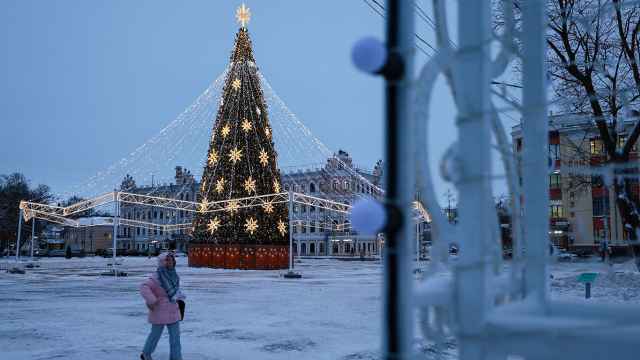Nina Akopova and her husband, Konstantin, woke up early on a 1979 morning as their daughter Irina slept between them.
The trio occupied a small tent at a summer camp on the Black Sea, and Nina, worried that the 4-year-old girl might wake up as well, carefully lifted the still-sleeping child above her body as she huddled with her husband.
The family had arrived at the camp in Abkhazia from their home in Tbilisi two days earlier. They had rented a vacation house in Gudauta, a popular beach resort, but had stopped here first to meet friends. The camp in Babushara was run by the military, and both Nina and Konstantin's parents were officers.
That Aug. 6 morning they planned to make the remaining hour's drive to the vacation house in their Zhiguli car.
But their summer vacation came to a tragic end before it had properly begun.
Somehow, Konstantin Akopov sensed something ill in the air.
"My husband suddenly said there must be something terrible around," Nina recalled. The two did not speak further in order not to wake up their daughter. At 6.20 a.m., the lightning struck.
"There was a massive crack, and almost simultaneously a fiery thread entered the tent," Nina said.
The tent, a Polish-made fabric in bright orange, was standing at the camp's entrance, next to their car. The lightning entered through a window laced with a mosquito net and left both the net and the whole tent intact.
Nina Akopova, now 56, said she remembers in detail what happened afterward, even though the event occurred 32 years ago and probably lasted less than a minute.
The glowing thread started to swirl, curling up like a ball of wool. But it looked more like a ball of fire, blindingly bright, although the inside seemed darker.
The Akopovs were both physicists and worked in a Tbilisi institute that developed electronics components. Nina said she immediately understood what had happened: Ball lightning had entered the tent.
The size of a tennis ball, it began floating through the tent. "It was like it was looking for a way out," she said.
In a knee-jerk reaction, she tried to leap up to open the tent's zipper in front of her. But she could not. "There was some overwhelming energy around me — I just could not move farther than get on my knees," she said.
The glaring ball kept floating through the tent. While moving up and down, it slowly transformed into a flat, pancake-like shape.
"It was like watching a movie in slow motion," Nina said.
Suddenly the ball exploded. And lots of things happened at once. To Nina it seemed that the whole place was on fire. But that proved to be an illusion.
Someone cut the tent open with a knife. A soldier stooped down and took little Irina into his arms. Rain abruptly started pouring down, the child's eyes were wide open, but she did not move.
Nina panicked. "I thought we are all dead. I had to save the child." But then she noticed her husband had stopped breathing.
The soldiers rushed to their rescue and grabbed the family members. One carried the girl to a cluster of houses at the center of the camp, others helped her parents.
Nina had a terrible headache, but she could walk. She was given army boots and escorted to a nearby hospital. They drove in a military bus, where Konstantin was given artificial respiration. The sun was shining again. Nobody spoke.
Upon arrival, they found that their efforts were in vain. "The doctor just looked at Konstantin, immediately covered his body with a sheet, and asked me why I was bringing him a dead man," Nina said.
The deadly lighting had actually struck both parents. Each had a biggish wound of dry, burned flesh near their left elbow, where Nina carries a scar to this day.
It emerged that she was lucky because the energy passed down to her hand, exiting her body through her fingers, which also suffered burns.
Konstantin was less fortunate. The lighting force moved upward through his left arm into his body, through his heart and down his right foot. A burn at his little toe marked the exit.
He was 25 years old.
Nina said his body was covered with dark lines, as if his nervous system had been burnt from the inside.
When she returned to the camp, she found one big relief. Her daughter, who had been whisked away from her in the chaos, had suffered a burn on her forehead but was alive. Doctors later found that she had been partly blinded — but could not really tell by what. To this day, her left eye is weaker and has a smaller pupil.
Speaking in an hourlong interview earlier this month on a busy square across from Moscow's Belarussky Station, Nina Akopova said she had never related her dramatic story in public.
"I just couldn't do it," she said. But she agreed to speak to a reporter after being contacted through relatives.
Ball lightning is one of the last remaining riddles of nature. So little is known about the phenomenon that some scientists even deny it exists at all, claiming that it is an illusion.
The first fatal ball lightning incident was recorded in Russia: In 1753, Georg Richmann, a scientist of Baltic German ancestry, was apparently electrocuted when ball lightning struck his head while he measured the atmospheric electric charge with a metal rod during a thunderstorm in St. Petersburg.
In recent years, reports of ball lightning have surfaced regularly during the summer months.
On Aug. 8, ball lightning scared a group of German tourists traveling in a bus through the Kaliningrad exclave.
An eyewitness told the local klops.ru web site that a bright white ball suddenly appeared near the bus' antenna, dissipated through the front window and exploded in the vehicle's dashboard. Nobody was hurt, but the brand-new bus had to be replaced, the report said.
In July, reports from Tuva said that ball lightning killed more than 80 sheep huddled under a pine in the remote south Siberian region.
Days later, ball lightning was sighted in downtown Moscow — on the 21st floor of the New Arbat high-rise that also houses Ekho Moskvy radio. "It was dangling next to an open balcony door and exploded after a few seconds, almost deafening our colleague who was taking a smoking break," the station's deputy editor Vladimir Varfolomeyev wrote in his blog.
In 2010, Lyalya Khaibullina, a trolleybus conductor in Kazan, achieved national fame when she recalled on state television how she fought off ball lightning in the trolleybus by throwing her electronic ticket vending machine at it.
Theories abound on how to explain ball lightning, but so far experts have failed to agree on any one of them.
Among the hypotheses discussed is one by a German scientist who says normal lightning can turn into ball lightning when it strikes a puddle.
Vladimir Bychkov, a plasma physicist at Moscow State University and vice president of the International Committee on Ball Lightning, favors another theory that says the mysterious balls consist of vaporized silicon.
For this to happen, lightning striking the soil anatomizes silicon dioxide into pure silicon and oxygen. The theory postulates that the silicon then escapes from the lightning's path and becomes an aerosol cloud. The burning effect is explained by the chemical reaction to the air's oxygen.
That theory could explain one of the most vexing riddles: how ball lightning can seemingly pass through windows and other closed objects. It has even been witnessed in airplanes.
The downside, Bychkov conceded, is that the theory is weak at explaining how the fiery clouds carry so much energy.
"The main problem is that we have not been able to reproduce this satisfactorily in a laboratory," he said in a telephone interview.
Maybe the lack of proper scientific explanations has promoted eyewitnesses' impressions that they have encountered something supernatural.
Stanislav Filatov, a retired physicist, remembers ball lightning entering his parents' apartment in the Moscow region town of Domodedovo through a closed window during a thunderstorm in summer 1937.
"It came right through the glass, hovered over the windowsill, and disappeared again through the glass," he said by telephone.
Filatov, who is 79, said the incident became deeply ingrained in his memory because it marked a turn in his family's situation — only weeks later his father was arrested during the Stalinist purges. "After this, life became bitter," he said.
Nina Akapova, although a trained physicist, also puts the tragedy of her husband's death into perspective, noting that Aug. 6 was the anniversary of an appearance of ball lightning inside one of the Kremlin's Cathedrals.
Indeed, it is striking that many of the ball lightning accounts in Russia are linked to the Russian Orthodox Church.
A prominent account found in church-sponsored biographies is of Tsar Nicholas II, who recalled a night mass with his father, Alexander III, during his childhood in St. Petersburg.
While a thunderstorm raged outside, "a fiery ball" came flying from the window straight to the emperor's head. After whirling around the floor, the lightning ball flew out through the door into the park, according to a report on the Orthodox.net web site.
More recent reports include one from the Diveyevo Monastery in the Nizhny Novgorod region, where ball lightning is said to have appeared on the altar in summer 2000 during a mass celebrated by the then-Patriarch Alexy II.
The patriarch cancelled the service but "it was said that this episode led him to agree to canonize Tsar Nicholas," which duly happened in August of the same year, historian Viktor Kuznetsov wrote in his book "Russian Golgotha," published in 2003.
Bychkov, the physicist, had a more profane explanation for the frequency of ball lightning reports in churches.
He explained that the design of most Orthodox houses of worship, which come with multiple metal spires and have a multitude of metal objects inside, tends to attract lightning.
"Basically, a typical Orthodox church is a perfect lightning rod," he said.
While ball lightning is an extremely rare phenomenon, fatal incidents are even rarer.
Bychkov said recent U.S. statistics found that out of 600 confirmed sightings, only four or five — less than 1 percent — ended with a human death.
However, the chances of unravelling the mystery in the near future are slim because very little research has been devoted to it. Globally, Bychkov said, only some 70 scientists currently do meaningful work in the field. The reason, he said, is a lack of interest and resources.
"Millions are poured into black holes, although no one has ever seen them," he said. "Ball lightning, with thousands of approved sightings, gets almost nothing."
A Message from The Moscow Times:
Dear readers,
We are facing unprecedented challenges. Russia's Prosecutor General's Office has designated The Moscow Times as an "undesirable" organization, criminalizing our work and putting our staff at risk of prosecution. This follows our earlier unjust labeling as a "foreign agent."
These actions are direct attempts to silence independent journalism in Russia. The authorities claim our work "discredits the decisions of the Russian leadership." We see things differently: we strive to provide accurate, unbiased reporting on Russia.
We, the journalists of The Moscow Times, refuse to be silenced. But to continue our work, we need your help.
Your support, no matter how small, makes a world of difference. If you can, please support us monthly starting from just $2. It's quick to set up, and every contribution makes a significant impact.
By supporting The Moscow Times, you're defending open, independent journalism in the face of repression. Thank you for standing with us.
Remind me later.







